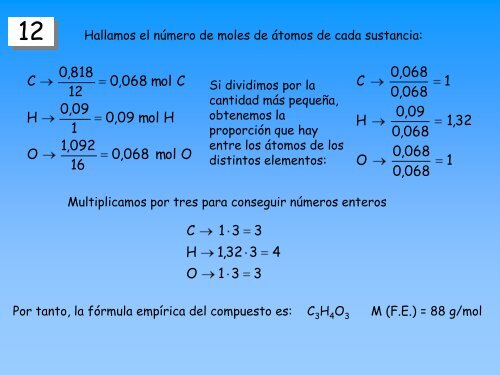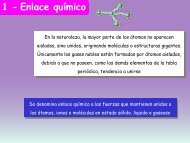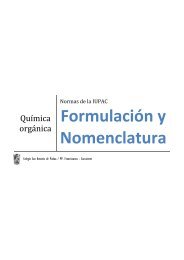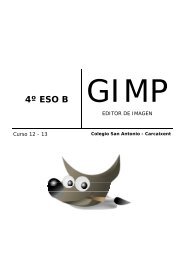En el caso del cobalto, al estar formado por un único isótopo, la ...
En el caso del cobalto, al estar formado por un único isótopo, la ...
En el caso del cobalto, al estar formado por un único isótopo, la ...
Create successful ePaper yourself
Turn your PDF publications into a flip-book with our unique Google optimized e-Paper software.
12 H<strong>al</strong><strong>la</strong>mos <strong>el</strong> número de moles de átomos de cada sustancia:<br />
C<br />
H<br />
0,<br />
818<br />
12<br />
0,<br />
09<br />
1<br />
0,<br />
068 mol C<br />
0,<br />
09 mol H<br />
Si dividimos <strong>por</strong> <strong>la</strong><br />
cantidad más pequeña,<br />
obtenemos <strong>la</strong><br />
pro<strong>por</strong>ción que hay<br />
C<br />
H<br />
0,<br />
068<br />
0,<br />
068<br />
0,<br />
09<br />
0,<br />
068<br />
1<br />
1,<br />
32<br />
O<br />
1,<br />
092<br />
16<br />
0,<br />
068 mol O<br />
entre los átomos de los<br />
distintos <strong>el</strong>ementos: O<br />
0,<br />
068<br />
0,<br />
068<br />
1<br />
Multiplicamos <strong>por</strong> tres para conseguir números enteros<br />
O<br />
1,<br />
32<br />
Por tanto, <strong>la</strong> fórmu<strong>la</strong> empírica d<strong>el</strong> compuesto es: C 3 H 4 O 3<br />
C<br />
H<br />
1<br />
1<br />
3<br />
3<br />
3<br />
3<br />
3<br />
4<br />
M (F.E.) = 88 g/mol






